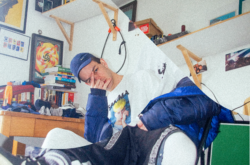New Jersey-based producer Seth Haley produced music under a number of pseudonyms prior to establishing himself as Com Truise, an outlet for what he calls “slow-motion funk.”
He describes the style as warped, bass-heavy tracks that are leavened with bright synthesizer melodies. In this interview, we sat down with Com Truise to discuss his gear, sound design techniques, and more.
Can you tell us about your studio setup and, of course, your synth collection? Walk us through your creative space and the tools you use to create.
My studio is in my home – I really prefer being able to wake up, make some coffee, and get right to work, as most of my creativity seems to surface early in the morning these days. I went for years never feeling like I had the proper workstation, so I finally bought a nice desk and it almost completely changed my life. It’s a Argosy HALO Plus, and I highly recommend it.
Contained within the desk are a few pieces of my go-to outboard processing equipment. I’m using an ADR Compex F760X RS, Eventide H3500 DFX, and ELI FATSO. I also had an OTO BIM and BAM in my patchbay. I use an Apollo 8 DUO for my interface, and I use a pair of ADAM A8Xs for my monitors. My DAWs of choice are Ableton and Reason. I currently work mostly in Ableton, but I have used Reason for about 14 years.
The synths I currently have in rotation are the Crumar Bit One, Juno 106, Sequential Prophet 6, DSI OB6, Oberheim Xpander, Oberheim Matrix 6, Korg ARP Odyssey, Access Virus TI2, and loads of Eurorack modules. I’ve been limiting myself and selling off some equipment to really just focus on developing my sound, rather than collecting for collecting’s sake. I think having too many options can negatively affect my creative process – definitely trying to lighten my studio and really only keep what I truly use regularly.
Do you have specific go-tos for leads, basses, pads, etc.? Do you find yourself still diving into new hardware?
I tend to not have too much of a formula when writing and recording. I could use the same synth for bass, leads, pads, etc. I like the unpredictability of using a synth that most wouldn’t, for a specific section of my sound. Lately, I’ve been starting everything with the Bit One or the Juno 106. I definitely keep up with new hardware, but I think my interests have shifted a bit from synthesizers to outboard processing / recording equipment.
Talk to us about your processing and approach to sound design. Are you working mostly in the box (in your DAW) for your processing?
Over the years, I have built a lot of processes that I tend to fall back on when I’m not feeling extremely inspired. Creating the sample pack was very interesting, since I felt like I was letting my processes out into the world in a more raw form – at once they felt like my secret or a family recipe.
It was almost refreshing to use them in this way, and then start fresh and build new processes. I work both in and out of the box. Sometimes in a rush I’ll use the box. I have no shame in using the box – the only shame I might feel is that I have some amazing outboard gear that would love to be used. I use procrastination as a tool as well – if I’m given too much time, I tend to noodle around with things until I lose interest.
Can you tell us a bit more about creating your sample pack?
It took me a bit of time to wrap my head around it to be honest! I really wasn’t sure where to begin. So, I just slowly began creating and manipulating drum samples, and honestly that just kind of sparked the rest of the content. I think I was feeling overwhelmed, but once I got my nomenclature sorted out, things began to really take off and I just kind of found my stride and creativity.
Despite incorporating so many sounds and tons of analog gear, your tracks maintain clarity and precision. Do you mix your own tracks? Are there any EQs, compressors, VSTs, etc. that you favor when it comes to mixing?
I mix all of my own tracks; most often, I tend to mixdown as the song naturally progresses. I like having access to everything, though writing and mixing at the same time can be difficult. I’ve been using a lot of the Universal Audio plugins for mixing as of late. I love the Chandler Limited Curve Bender Mastering EQ, Chandler Limited Zener Limiter, AMS Neve DFC Channel Strip, and the Ampex ATR-102.
Your music feels timeless in how it combines modern approaches and classic gear. Is there a particular era in gear production that you favor? Are there any particular stand-out synths or keyboards that you treasure?
I don’t focus too much on a specific era, but I tend to like the sound and tone of things in production before 1988. I’d have to say that my favorite synths as of late are the Crumar Bit One and the Oberheim Xpander. The Crumar is a very strange synth; it’s a bit unpredictable, but more often than not the results are pretty amazing. The Xpander is just a beautiful synth – so bright, yet still pretty warm. I’m big on Oberheim synths.
Lastly, how do you keep your creativity flowing?
I often have a film playing silently in the background that I occasionally look at, and this seems to keep my creativity moving. It’s a sort of tool I tend to use to jog ideas further into shape.
Dive into moody and lush synthwave vibes in Com Truise’s “Nvision” sample pack.
Get fresh, original, and exclusive releases daily from top artists, producers, and sound designers across genres:
February 22, 2019



